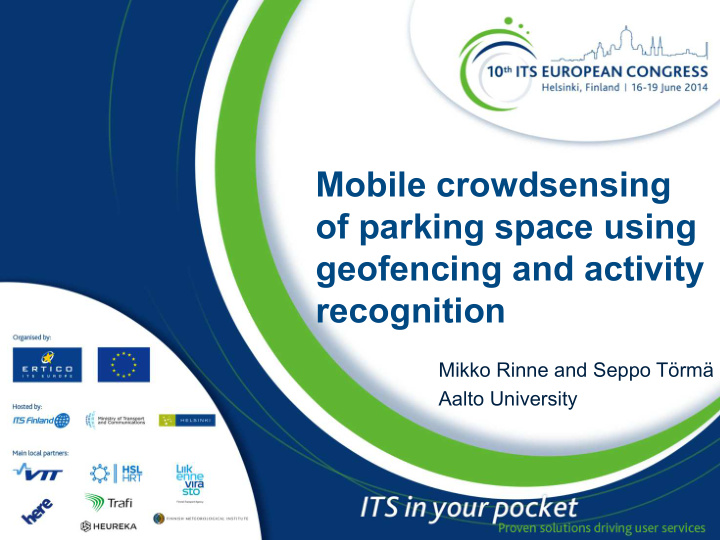



Mobile crowdsensing of parking space using geofencing and activity recognition Mikko Rinne and Seppo Törmä Aalto University
Three ¡Methods ¡of ¡Gathering ¡ Parking ¡Status ¡Informa7on ¡ 1. Infrastructure ¡sensors ¡ – Loop ¡detectors ¡(or ¡cameras) ¡for ¡entrances ¡of ¡parking ¡areas ¡ – Detectors ¡for ¡individual ¡parking ¡squares ¡ – Requires ¡suppor7ng ¡infrastructure ¡investment ¡ 2. Crowdsourcing ¡ – User ¡repor7ng ¡of ¡parking ¡area ¡status ¡ Full, ¡almost ¡full, ¡plenty ¡of ¡space ¡ • – Ac7ve ¡method ¡– ¡requires ¡effort ¡from ¡a ¡user ¡ 3. Crowdsensing ¡ ¡ – Parking ¡status ¡informa7on ¡gathered ¡from ¡sensors ¡of ¡a ¡mobile ¡ device ¡ – Passive ¡method ¡-‑ ¡requires ¡only ¡minimal ¡user ¡interac7on ¡
Android ¡Sensors ¡ • Geofences ¡ – A ¡circular ¡geographical ¡area ¡can ¡be ¡defined ¡ – The ¡service ¡produces ¡Enter ¡and ¡Exit ¡events ¡ • Ac7vity ¡recogni7on ¡ – In ¡vehicle, ¡On ¡foot, ¡and ¡On ¡bicycle ¡(also ¡Til7ng, ¡S7ll) ¡ • Fused ¡loca7on ¡provider ¡ – Combines ¡informa7on ¡from ¡GPS, ¡cell ¡loca7on, ¡Wi-‑Fi, ¡ and ¡sensors ¡(accelerometer, ¡barometer, ¡…) ¡ – Improved ¡energy-‑efficiency ¡and ¡accuracy ¡ – Enables ¡more ¡accurate ¡indoor ¡loca7on ¡
Parking ¡Area ¡Status ¡from ¡ Crowdsensing ¡ Car ¡drives ¡to ¡the ¡parking ¡lot ¡and ¡exits ¡immediately ¡ or ¡ circles ¡for ¡an ¡extended ¡period ¡ Start ¡ or ¡ explicit ¡user ¡input ¡ T 1 ¡ ¡ Free ¡ Full ¡ passes ¡with ¡ Unknown ¡ no ¡ac7vity ¡ Car ¡stops ¡on ¡parking ¡lot ¡and ¡driver ¡con7nues ¡on ¡foot ¡ or ¡ a ¡parked ¡car ¡leaves ¡ or ¡ explicit ¡user ¡input ¡
PaXerns ¡of ¡Parking-‑Related ¡Events ¡ Successful ¡parking ¡ End ¡of ¡parking ¡ Failed ¡parking ¡a3empt ¡ 1. enter ¡geofence ¡ 1. enter ¡geofence ¡ 1. enter ¡geofence ¡ 2. on ¡foot ¡ 2. in ¡vehicle ¡ 2. in ¡vehicle ¡ 3. in ¡vehicle ¡ 3. on ¡foot ¡ 3. exit ¡geofence ¡ 4. exit ¡geofence ¡ (within ¡a ¡short ¡ 4. exit ¡geofence ¡ dura7on) ¡ ¡ ¡ ¡ Infer : ¡the ¡parking ¡area ¡ ¡ Infer : ¡free ¡space ¡in ¡the ¡ Infer : ¡free ¡space ¡ ¡ is ¡full ¡ parking ¡area ¡ in ¡the ¡parking ¡area ¡ Visible ¡and ¡invisible ¡drivers! ¡
SPIRE ¡Applica7on ¡Architecture ¡ Google ¡cloud ¡ services ¡ 3. ¡RDF ¡Graph ¡ Storage ¡ A. ¡Sign-‑in, ¡ search ¡ maps, ¡ 4. ¡Infra-‑ ¡ D. ¡SPARQL ¡ E. ¡RDF ¡ structure ¡ sensors ¡ C. ¡P-‑area ¡data ¡ 1. ¡Client ¡ updates ¡ 2. ¡HTTP ¡Server ¡ B. ¡User ¡and ¡sensor ¡ input ¡
Mobile ¡Client ¡Screen ¡Captures ¡ Manual ¡Status ¡Input ¡ Map ¡View ¡ Parking ¡Lot ¡Info ¡
Event ¡Trace ¡Example ¡ Table 1: Sample log of a successfully detected parking procedure Time: Type: Event: 11:51:45 Geofence <Computer Science Building, Guest parking> <Enter> 11:51:54 Activity <IN_VEHICLE> 11:51:55 Location 60.187546 24.82136 Location ...extra GPS coordinates removed... 11:52:40 Location 60.18752 24.821259 11:53:01 Activity <ON_FOOT> 11:53:01 Geofence <Computer Science Building, Guest parking> <Exit>
Challenges ¡ • Algorithmic ¡imperfec7ons ¡ – Full ¡parking ¡area ¡detec7on ¡vic7m ¡ – Challenging ¡geometries ¡ • Drive-‑thru ¡ • Small ¡parking ¡areas ¡(Heterogeneous ¡permissions) ¡ – Drivers ¡invisible ¡to ¡the ¡system ¡ • Technical ¡challenges ¡ – Power-‑consump7on ¡vs. ¡geofence ¡entry ¡detec7on ¡ – Ac7vity ¡recogni7on ¡uncertainty ¡ • Human ¡factors ¡in ¡crowdsourcing ¡
Conclusions ¡ • Benefits ¡of ¡crowdsensing ¡ – No ¡infrastructure ¡investment ¡ – No ¡manual ¡effort ¡from ¡the ¡user ¡ – Good ¡for ¡large, ¡homogeneous ¡parking ¡areas ¡and ¡high ¡ user ¡penetra7on ¡ • Crowdsensing ¡is ¡not ¡a ¡complete ¡solu7on ¡ – Does ¡not ¡work ¡well ¡for ¡all ¡geometries ¡ • Crowdsensing ¡can ¡be ¡one ¡source ¡of ¡informa7on, ¡ but ¡it ¡needs ¡to ¡be ¡complemented ¡by ¡ infrastructure ¡sensors ¡and ¡crowdsourcing, ¡where ¡ appropriate ¡
Recommend
More recommend